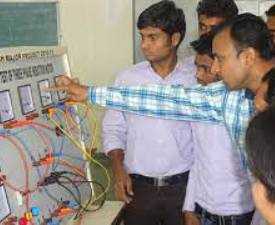Description
Course Name: Diploma in Electrician
Course Id: DIE/Q1001.
Education Qualification: 10th Pass.
Duration: 370 Hrs.
How You will Get Diploma Certificate:
Step 1- Select your Course for Certification.
Step 2- Click on Enroll Now.
Step 3- Proceed to Enroll Now.
Step 4- Fill Your Billing Details and Proceed to Pay.
Step 5- You Will be Redirected to Payment Gateway, Pay Course and Exam Fee by Following Options.
Card(Debit/Credit), Wallet, Paytm, Net banking, UPI and Google pay.
Step 6- After Payment You will receive Study Material on your email id.
Step 7- After Completion of Course Study give Online Examination.
Step 8- After Online Examination you will get Diploma Certificate soft copy(Scan Copy) and Hard Copy(Original With Seal and Sign).
Step 9- After Certification you will receive Prospect Job Opportunities as per your Interest Area.
Online Examination Detail:
- Duration- 120 minutes.
- No. of Questions- 60. (Multiple Choice Questions).
- 10 Questions from each module, each carry 10 marks.
- Maximum Marks- 600, Passing Marks- 40%.
- There is no negative marking in this module.
| How Students will be Graded: | ||
| S.No. | Marks | Grade |
| 1 | 91-100 | O (Outstanding) |
| 2 | 81-90 | A (Excellent) |
| 3 | 71-80 | A (Very Good) |
| 4 | 61-70 | B (Good) |
| 5 | 51-60 | C (Average) |
| 6 | 41-50 | P (Pass) |
| 7 | 0-40 | F (Fail) |
Benefits of Certification:
- Government Authorized Assessment Agency Certification.
- Certificate Valid for Lifetime.
- Lifetime Verification of Certificate.
- Free Job Assistance as per your Interest Area.
Syllabus
Diploma in Electrician
Electrical Instruments & Measurement
Basics of Measurements: Accuracy, Precision, resolution, reliability, repeatability, Validity, Errors and their analysis, Standards of measurement .Bridge Measurement: DC bridges- wheat stone bridge, AC bridges – Kelvin, Hay, Max well, Schering and Wien bridges, Wagner ground Connection. Electronic Instruments for Measuring Basic Parameters: Amplified DC meter, AC Voltmeter, True- RMS responding Voltmeter, Electronic multi-meter, Digital voltmeter, Vector Voltmeter. Oscilloscopes: Cathode Ray Tube, Vertical and Horizontal Deflection Systems, Delay lines, Probes and Transducers, Specification of an Oscilloscope. Oscilloscope measurement Techniques, Special Oscilloscopes – Storage Oscilloscope, Sampling Oscilloscope Signal Analysis: Wave Analyzer, Spectrum Analyzer. Frequency Counters: Simple Frequency Counter; Measurement errors; extending frequency range of counters Transducers: Types, Strain Gages, and Displacement Transducers. Signal Generators: Sine wave generator, Frequency – Synthesized Signal Generator, Sweep frequency Generator. Pulse and square wave generators. Function Generators.
Power Electronics
Linear Algebra, Calculus, Differential equations, Analysis of complex variables,
Probability and Statistics, Numerical Methods Electrical Circuits,Signals and Systems, Control Systems, Feedback principles, signal flow graphs, transient response, steady-state-errors, Bode plot, phase and gain margins, Routh and Nyquist criteria, root loci, design of lead, lag and lead-lag compensators, time-delay systems; P, P-I, P-I-D, cascade, feed forward, and ratio controllers. Analog Electronics, Digital Electronics Measurements, Sensors and Industrial, Instrumentation, Communication and Optical Instrumentation, State space representation, controllability, observability, state feedback control, pole-placement, Programming skills Digital Communications.
Electrical Design & Drawing
The importance of electrical engineering design, drawing and Estimating for electrical technician has already been explained in the rationale of the subject, Electrical Engineering Design, Drawing & Estimating, The aims of teaching Electrical Engineering Design, Drawing & Estimating, are to develop the following abilities. To read and interpret electrical engineering drawings,to communicate and corelate through sketches and drawings, the actual machine and to impart instructions to the workman, To prepare working drawing of alternator panel.
Transmission & Distribution of Electricity
Lay out of HT and LT distribution system, constructional feature of distribution lines and their erection. LT feeders and service mains; Simple problems on AC radial distribution system, determination of size of conductor Preparation of estimates of HT and LT lines (OH and Cables).Constructional features of LT (400 V), HT (II kV) underground cables, advantages and disadvantages of underground system with respect to overhead system. Losses in distribution system Faults in underground cables-determine fault location by Blavier Test, Murray Loop Test, Varley Loop Test.Brief idea about substations; outdoor grid sub-station 220/132 KV, 66/33 KV outdoor substations, pole mounted substations and indoor substation.
Electrical M/c
Flow of Energy in Electromechanical Devices, Energy in magnetic systems (defining energy & Co-energy), Singly excited systems; Determination of mechanical force, Mechanical energy, Torque equation, Doubly excited Systems; Energy stored in magnetic field, Electromagnetic torque , Generated emf in machines; Torque in machines with cylindrical air gap. – Construction of DC Machines, Armature winding, Emf and torque equations, Armature reaction, Commutation, Interpoles and compensating windings, Performance characteristics of D.C. generators. Performance characteristics of D.C. motors, Starting of D.C. motors; 3 point and 4 point starters, Speed control of D.C. motors; Field control, Armature control and Voltage control (Ward Lenonard method); Efficiency and Testing of D.C. machines (Hopkinson’s and Swinburn’s Test).
Digital Electronics & Microprocessor
Combinational Digital Circuits: Standard representation for logic functions, K-map representation, simple fiction of logic functions using K-map, minimization of logical functions. Don’t care conditions, Multiplexer, De-Multiplexer/Decoders, Adders, Sub tractors, BCD arithmetic, carry look ahead adder, serial adder, ALU, elementary ALU design, parity checker / generator. Sequential circuits and systems: A 1-bit memory, the circuit properties of Bitable latch, the clocked SR flip flop, J- K – T and D-types flip flops, applications of flip flops, shift registers, applications of shift registers, serial to parallel converter, parallel to serial converter, ring counter, sequence generator, ripple (Asynchronous) counters, synchronous counters, counters design using flip flops, special counter ICs, asynchronous sequential counters, applications of counters.
Electrical Machine Lab
Operating principle, classification, construction, emf equation, phasor diagrams, equivalent circuit model, losses & efficiency, voltage regulation, frequency response, polarity test, autotransformers, three-phase transformer connections, impedance matching, isolation & instrument transformers. Operating principle, generator & motor action, construction, types of excitation, emf& torque equations, power stages & efficiency Commutation & Armature Reaction, characteristics & application of d.c generators, starting & speed control of d.c motors, characteristics & applications of d.c motors, electric braking. Output equation, Main dimensions, Armature design, Armature windings.

